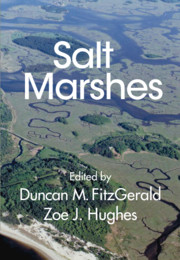Book contents
- Salt Marshes
- Salt Marshes
- Copyright page
- Contents
- Contributors
- Acknowledgments
- 1 State of Salt Marshes
- Part I Marsh Function
- Part II Marsh Dynamics
- 7 Marsh Equilibrium Theory
- 8 Salt Marsh Ecogeomorphic Processes and Dynamics
- 9 Salt Marsh Sediments as Recorders of Holocene Relative Sea-Level Change
- 10 Storm Processes and Salt Marsh Dynamics
- 11 Understanding Marsh Dynamics
- 12 Understanding Marsh Dynamics
- Part III Marsh Response to Stress
- Index
- References
9 - Salt Marsh Sediments as Recorders of Holocene Relative Sea-Level Change
from Part II - Marsh Dynamics
Published online by Cambridge University Press: 19 June 2021
- Salt Marshes
- Salt Marshes
- Copyright page
- Contents
- Contributors
- Acknowledgments
- 1 State of Salt Marshes
- Part I Marsh Function
- Part II Marsh Dynamics
- 7 Marsh Equilibrium Theory
- 8 Salt Marsh Ecogeomorphic Processes and Dynamics
- 9 Salt Marsh Sediments as Recorders of Holocene Relative Sea-Level Change
- 10 Storm Processes and Salt Marsh Dynamics
- 11 Understanding Marsh Dynamics
- 12 Understanding Marsh Dynamics
- Part III Marsh Response to Stress
- Index
- References
Summary
Early geoscientists recognized that salt marsh sediment overlying terrestrial deposits (e.g., soil containing the preserved, in-situ stumps of freshwater trees) represented submergence of the older, buried landscape at a time in the past (e.g., Bartram, 1791; Lyell, 1849). After the development of radiocarbon dating in the late 1940s (e.g., Libby 1961) it became possible to determine when salt marsh sediment was deposited and sea-level research began to focus first on building and then on interpreting Holocene relative sea level (RSL) curves (e.g., Bradley, 1953; Redfield and Rubin, 1962; Bloom and Stuiver, 1963; van de Plassche et al. 1989; Gehrels et al. 1996; Shennan and Horton, 2002). Conceptually relative sea level (RSL) is the elevation of the sea surface relative to the land surface at a specific location and averaged over a period of time to negate the influence of tides and seasonal to annual variability. For example, RSL measured by tide gauges is often expressed as a monthly or annual average, while RSL reconstructions from coastal sediment are inherently time averaged over several years to decades. A variety of physical processes acting on local-to-global spatial scales and on temporal scales from minutes to millennia can cause RSL to change across space and through time. Therefore, measured or reconstructed RSL is specific to a time and place and is often the net outcome of multiple processes acting simultaneously. Proxy-based RSL reconstructions generated by interrogation of salt marsh sediment preserved in the coastal stratigraphic record are valuable in advancing our understanding of Holocene climate (e.g., Kemp et al. 2011), the structure of Earth’s interior (e.g., the viscosity and structure of the mantle; e.g., Shennan and Horton, 2002; Engelhart et al. 2011a), and of physical driving mechanisms of past, present, and future sea-level change (e.g., Kopp et al. 2016).
Keywords
- Type
- Chapter
- Information
- Salt MarshesFunction, Dynamics, and Stresses, pp. 225 - 256Publisher: Cambridge University PressPrint publication year: 2021
References
- 2
- Cited by

